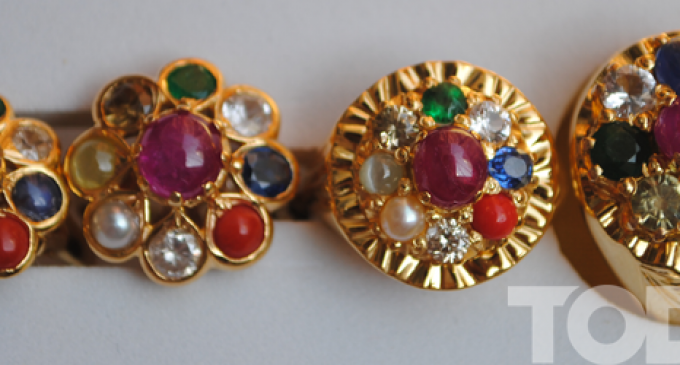THE NINE-JEWELLED RING

All human beings treasure their lives; they all aspire after a life of greater happiness, greater wealth, greater power and glory. To achieve these ends they wear jewels as good-luck charms. It is the case particularly with those who can afford charm jewels of various kinds — mostly those varieties Myanmars call nawarat, the Nine Varieties of jewels. Each of the Nine has its own power and charm, as a treatise on gems and jewels called Manishattara says:
Ruby makes for power;
Emerald for calm and tranquility;
Diamond makes for glory;
Cat’s eye makes for accomplishment and fulfilment;
Sapphire makes for love and affection;
Garnet makes for strength and vitality;
Topaz makes for health and vigour;
Coral makes for headship and leadership;
Pearl makes for magnificence and grandeur;
Wearing the Nine jewels as charms dates back to the days of Ratanabon Era kings. They were then worn by members of the royal family and palace officials, not by common people who could not afford them or who were just afraid to wear them.
Nowadays a great number of people have begun to wear Nine-jewelled (nawarat) finger-rings as charm rings. The way they are worn must be systematic, even the way they are laid out in setting: coral must be placed in the northeast, diamond in the east, pearl in the southeast, Cat’s eye in the south, garnet in the southwest, emerald in the west, Topaz in the northwest and sapphire in the north; ruby, which is regarded as king of jewels, must be set right in the centre that represents the position of the ninth planet.
The Nine-jewelled ring should be worn, with the emerald kept as closest to one’s side of the ring as possible and the diamond as farthest away as possible for the wearer to receive the cooling and calming effect of the emerald and the support and protection of the diamond whose iridescent rays, like arrowheads, are believed to possess the power of withstanding or warding off danger.
Some goldsmiths of run-of-the-mill type, making a Nine-jewelled ring, would make a bad job of it, while those goldsmiths who are knowledgeable about the technical difficulties it entails would be cautious in undertaking such a job. In the first place, the nine jewels have to be laid out on a clean, white piece of cloth in a methodical arrangement. The treatise Manishattara says a lighted candle must be offered to each jewel as an act of homage, and the jewels must be set with pollen of their matching flowers underneath them: musk (moschus moschiferus) and red lotus underneath the ruby; ngwebun (hedychium spicatum) and mace underneath the diamond; phonmathain (ngai camphor) and kayuthin (evolvulus alsinoides) underneath the pearl; kyetmaukni (cockscomb, celosia argentea) under -neath the Cat’s eye; (aloswood, agalochum) underneath the topaz; panyin (khuskhus) and nanttha (mille -tia Ovalifera) underneath the sapphire; musk lotus and sandalwood underneath the coral.
To make the ring more potent, setting should be done by those persons who respectively have an astrologically harmonious relationship with the jewels. Setting must coincide with the time when the planets which correspond with the jewels are at their zenith — an event that takes a long wait, often four or five years; however, people are patient enough to wait that long, believing that power of charm can vest only in a ring made in a systematic manner.
Some people wear Nine-jewelled rings as ornaments, others for more success in life and enhanced prestige, and still others for ostentation, taking pride in owning things, rare and precious. Opal, one of the Nine, does not actually exist in Myanmar, and that product of Mogok which people believe to be opal is in fact but a moonstone variety. Genuine opal exists only in mines in Sri Lanka, and has a grey-milky colour like that of puss.
Beliefs regarding charm jewels are wide-spread not only in Myanmar but also in the west, where selection of charm jewels is made on the basis of one’s day of birth, as follows:
For the Monday-born it is pearl; for the Tuesday-born, coral; for the Wednesday-born, emerald; for the Rahu-born, garnet; Thursday born, topas; for the Friday-born, diamond; for the Saturday-born, sapphire; and for the Sunday-born, ruby.
Also on the basis of one’s month of birth, as follows:
For the February-born, kayanzwe; the March-born, myapya; April-born, diamond; May-born, emerald; June-born, pearl; July-born, ruby; August-born, opal; September-born, sapphire, October-born, opal; November -born, the French marigold; and December-born, turqoise.
To sum up, it is obvious that peoples in different parts of the world share the same value and cherished feelings regarding jewels. The people in Myanmar love jewels, and they wear Nine-jewelled rings as charm rings, convinced that they bring good luck.
Su Nway Oo
Translated by Nyunt Thaung
./wp-content/uploads/2018/10/Emirate-Online-TDY.png)


















Wow, this piece of writing is pleasant, my younger
sister is analyzing these things, so I am going to let know her.
That is a very good tip particularly to those new to
the blogosphere. Short but very precise information… Thanks
for sharing this one. A must read article!
Good way of explaining, and good paragraph to obtain facts concerning my presentation focus,
which i am going to deliver in college.